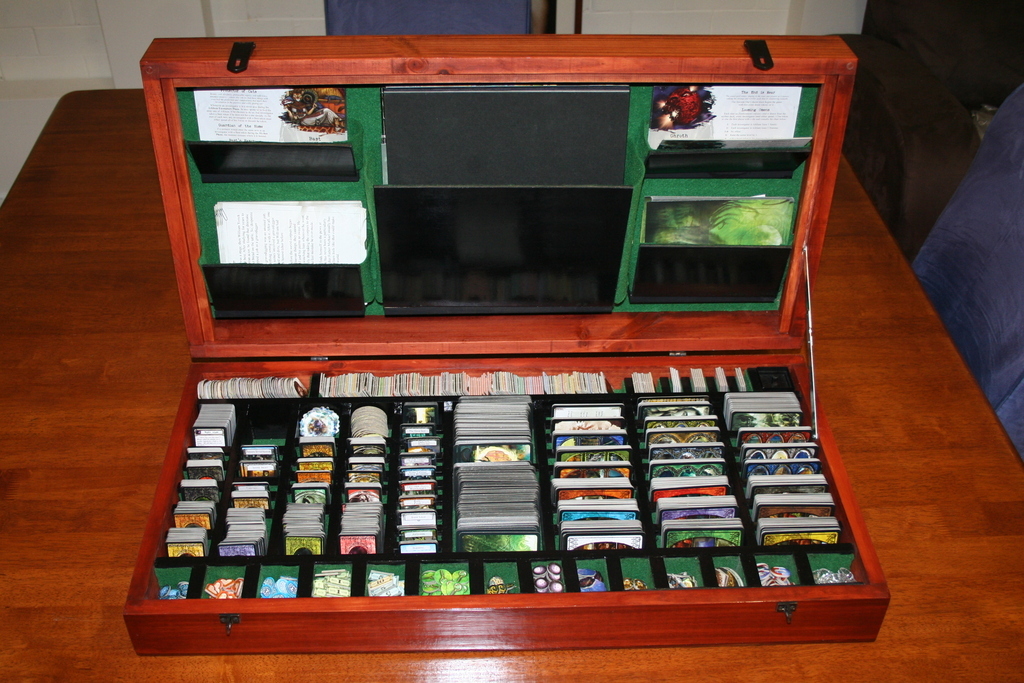Gaming 101 is a series of articles designed for new gamers. It will cover all the basics of gaming – from choosing a beginner’s game to hosting your first game night. Have something you want to see in Gaming 101? Email us or leave a note in the forums.
Lesson 4:
Game Storage
Welcome to our final installment of Gaming 101. By now, you’ve chosen and played at least one new game. I hope that you’ve enjoyed yourself, and that you’re on your way to becoming a full-fledged gamer.
With only one or two games under your belt, you likely haven’t spent much time thinking about storage just yet. Indeed, for awhile there’s not much need to. Keep your games on a shelf, try not to lose any pieces, and you should be all set.
Unless those one or two new games become ten. Or twenty. Or thirty.
Once your collection outgrows that shelf, you might need to put a little more thought and care into how you proceed. Why, though? Why not just grab a bigger shelf and get on with it? For one, the more games you amass, the more investment you’ve put into this hobby. A quick look around your local game store or website will tell you that most not-Candyland games aren’t cheap. But if you care for them they can easily last a lifetime. In fact, game boards dating back to King Charles in the 17th century have been found in great condition. (Granted, it helps when they’re not made of cardboard). Some games can also increase in value over the years. Like comic books, games are printed in relatively small batches. If the game is good, it might get a second printing, yet there is no guarantee. Years later, though, people might still be looking to play that game. A great example here is the original Dune by Avalon Hill. Its retail price was on par with other games in 1979 when it was released, but today it’s hard to find it for less than $100. This is the exception rather than the rule, but it demonstrates some of the less-obvious reasons to keep your game collection safe and well-organized.
 Of course, it doesn’t all come down to money. You may have noticed by now that a lot of games release expansions (or sequels) in the years after their initial publication. This can be great if it’s a game you love, but it’s also a hassle to find an easy way to store the base game with the expansion. After all, chances are you’ll want to keep them together whenever possible. Some expansions even ask you to mix the new game pieces in with the old; by then your game might not even fit in its original box.
Of course, it doesn’t all come down to money. You may have noticed by now that a lot of games release expansions (or sequels) in the years after their initial publication. This can be great if it’s a game you love, but it’s also a hassle to find an easy way to store the base game with the expansion. After all, chances are you’ll want to keep them together whenever possible. Some expansions even ask you to mix the new game pieces in with the old; by then your game might not even fit in its original box.
Ok, look, I know that these aren’t life-or-death issues. The Gamer Police aren’t going to break down your door for stacking your games the wrong way or not re-bagging all your pieces. But if you want to get the most out of your games for the longest amount of time possible, storage is something that you should give a few minutes’ thought to.
I’ll try to make this quick – I promise.
Now that I’ve convinced you to think about storage, there are two factors that you should pay attention to:
- Is the game safe from any possible avoidable damage?
- Will this allow us to set the game up efficiently?
Let’s look at these for a moment.
Is the game safe from any possible avoidable damage?
This one is mostly obvious. Don’t store your games under a leaky pipe, in extreme temperatures, etc. Games can take up valuable shelf space, and they’re often not something people use every day. So, the temptation is often there to put them somewhere out of the way from daily use. However, when you get down to it, most games are just pretty paper and cardboard that will deteriorate in damp basements and humid attics. They don’t have to be in your living room, but you’ll want to want to find a safe dry place to put them. They should be valued somewhere in importance below family photos but above your holiday decorations and seasonal sports equipment.
You should also pay attention to the way you stack your boxes. Some gamers advocate shelving games like books. In fact, some game manufacturers even design boxes specifically to fit into bookshelves. Proponents of bookshelf games say that the boxes take less wear since they’re not sitting under the pressure of a large stack of games. I can’t argue with this, but I also have to admit that it’s not a practice I use to store games. Unless all of your games fit into the bookshelf shape, it’s going to get messy and unwieldy. Instead, I’m careful to place the sturdiest boxes on the bottom and work my way up.
You also have to be concerned about protecting your game components from damage. We always advocate putting pieces in baggies to keep them from sliding around inside the box and potentially getting lost. If your game has a lot of cards involved (or is only cards) you might want to think about buying card sleeves. These are thin plastic pockets with clear fronts, and they hold one card each. Sleeving a gigantic deck can be a pain (I’m looking at you Dominion), but they keep your cards safe from the moisture and acid of your hands, as well as from general wear and tear. This adds years to a game’s longevity. They’re also generally inexpensive. It may be an extra $5 investment, but that’s a lot cheaper than spending $60 on a whole new copy of your favorite game.
Will this allow us to set the game up efficiently?
Ideally, game set up is simple and quick. In actuality, though, it can take quite awhile to get complex games ready to play. I mean, we play Arkham Horror with all of its expansions – that can take a solid twenty minutes to get out of the box(es) and onto the table.
So this is where our next point comes into play. You want your game storage to allow you to get all of your pieces out of the box as easily as possible. One way to do this is to individually bag all the different pieces – so player tokens can go in one bag, money in another, land tiles in yet another, and so on. This way, all you have to do is open the individual bags and drop your components onto the table. Of course, it makes cleaning up a bit of a hassle, but that’s often an acceptable trade off. You can use any baggies, from those found at your supermarket to general multipurpose bags that come in all different sizes.
You also want to try to keep game expansions with their base games whenever possible. Sometimes, this means that you have to get a little creative. At first, you may be able to get away with simply removing the molded plastic insert that comes with most games. Beyond that it could require forethought. For example, some people use fishing tackle boxes or craft bin organizers, with all their little dividers, to store pieces of large games. Other people create their own storage devices.
No matter how you decide to store your games, thinking about it before you’ve acquired a huge collection can be a major plus. If you can keep your games safe, dry, and organized, you’ll be playing them well into your old age. And hey, you’ll have a first edition.


